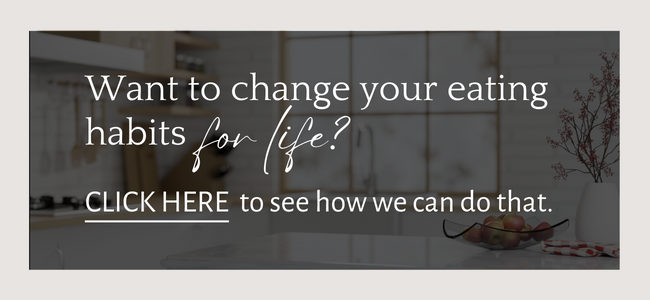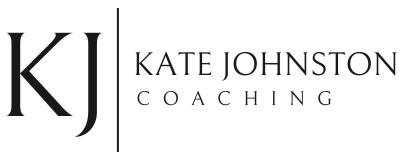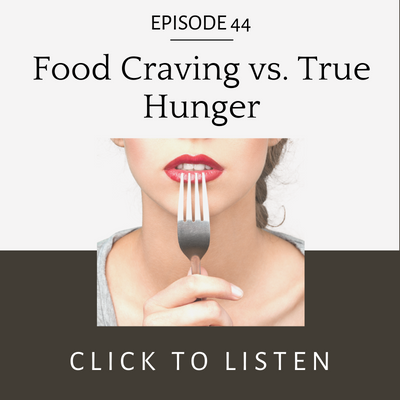Food Craving vs. True Hunger
Get all the latest episodes! Follow the show on Apple (iPhone) Here or Spotify Here.
It can be so tough to tell whether those hunger signals are because of a food craving or if they’re because of true hunger.
So, in this episode, I’m sharing 3 ways to tell if it’s a food craving vs. true hunger.
That way, you can start getting a better understanding on when you’re truly hungry or if it’s a craving just disguised as hunger.
From there, you can decide what to do next, so it’s deliberate and not on autopilot.
*To read the full episode transcript, scroll down.
Listen Below:
Related Episodes:
- Emotional Eating: Is It Even a Problem?
- 5 Best Ways to Avoid Failure
- Add the show to your podcast library on Apple (iPhone) Here or Spotify Here
Next Steps: Take Control of Your Eating Habits
Imagine the freedom and peace of overcoming emotional eating, overeating, and mindless eating… so you can achieve lasting weight loss.
Ready to break free for good?
Together, we’ll create a personalized pathway that works for you. Bringing clarity, relief, and encouragement. 📆 Book your free consult
Full Episode Transcript:
Food Craving vs. True Hunger
Hi there, welcome to the podcast. If you’re a first-time listener, then a double welcome to you. If you have been listening, then you know I usually skip the small talk in the beginning. However, my husband, Paul’s 50th birthday is coming up in just a few days, and he and I were talking about how much his life and lifestyle has changed in the past 12 years.
It’s pertinent to this podcast as a whole, so I thought I would tell you a little bit of our conversation.
So about 12 years ago, he started changing his eating habits and some exercise habits as well. He had a fairly sedentary lifestyle, at least compared to his lifestyle now.
His eating habits were not good, but that’s as per him, as I didn’t know him then. He used to feel bloated and have stomach pain when he didn’t have great eating habits. He would wake up in the middle of the night with heartburn.
Anyway, he had an experience that made him realized that he needed to start making some changes.
He started making some small changes, which evolved into more changes. He feels younger than he did in his 30s and in my opinion he looks incredible. He looks so much healthier. He is lean and muscular and athletic, and he does multiple sports. People are always shocked when they learn how old he is.
Now, it’s super easy for him to maintain all of this. And so while we were talking we were just talking about how what started out as some small changes 12 years ago, resulted in his life being completely different in all different areas, more than he ever expected.
Not even just with how he feels and looks, but the people he has met because of the changes that he made. The friendships that he has formed. The accomplishments that he has had from being able to do things physically that he wasn’t able to do before. Such good stuff.
So, as we celebrate his 50th coming up, he is very happy to still be playing beach volleyball at a very high level, weight lifting heavy weights in the gym, and even going for 10 mile runs. He really feels that he’s able to do all this because of his healthier eating habits. So, here’s to him, a very happy and healthy 50th birthday.
Alright, so, today I wanted to talk to you about a food craving versus true hunger in addition to telling you that little story to help inspire. So how exactly do you know when it’s a craving versus when it’s true hunger? That is the big question. Don’t worry, because I have 3 neat ways for you to be able to tell.
So I know you know what I mean by feeling as though you feel the hunger sensation but you don’t know if it is just a craving for food just because you want the food, or if it’s true hunger. This is what this podcast episode will clear up.
For example, you might sit down on the couch in the evening at the end of your busy day, and immediately feel like you want the snacks. But you just had dinner an hour ago.
So, are you really hungry or are you just thinking about the delicious food? Is it something else? Maybe. It may be any of these. So that’s why we’re gonna play little detectives and figure out what it is exactly.
Before we do that, I just want to give a couple of other examples.
Think about when you’re in the middle of the work day, and it’s 3:00 o’clock in the afternoon and you start getting the munchies.
Is it because you really need an afternoon snack or is it because of maybe a little bit of boredom setting in? Hard to tell sometimes, right?
So another example would be, if you’re on a long car trip and you feel like you are just constantly hungry during the trip. Constantly munching on the snacks that you brought along. This happens to me every time we are on a long car trip.
My thought is always, “I’m not very active right now, so I shouldn’t be that hungry.” But I always feel so hungry. I of course know what it actually is, it’s just that I am fairly bored on a long car trip, even despite great conversation or listening to a podcast.
Because I’m so inactive while driving a car or being a passenger for that long, I do start getting bored. The boredom triggers the craving for food.
Back to the question of food craving versus hunger.
So, a craving is also known as a desire or an urge. So, you might get the urge to eat a snack. You might get the desire to eat a snack. You might get the craving to eat a snack. All the same thing.
One of the things that might clue you into if it’s a craving, urge, or desire, if you feel an uncomfortable emotion beforehand. This is usually some sort of a negative emotion, but also can be an emotion seen as a more positive one.
Examples of negative emotions include boredom, stress, tension, irritation, anger, sadness, anxiety, and even craving. Yes, craving is an emotion. It’s not comfortable typically.
Therefore, if you’re already feeling a negative emotion such as boredom, you’ll notice that you’re bored and then your human brain by default wants that boredom to go away.
Food is an easy quick way for that boredom to go away sometimes. So then, you can start to get a craving for the food. A desire to eat the food. Especially if it’s a really tasty food, such as something sweet, salty or savory.
The craving is then also uncomfortable. So, combine the discomfort of the craving and the discomfort of the initial negative emotion like the boredom, and no wonder you want to eat the snacks, right?
No wonder I start getting snacky while on a long car ride. Because I have this awareness though, I always am sure to bring mostly healthy snacks with me.
So, the first way to tell if it’s a food craving vs. true hunger is this. We’re going to start with the food craving. With a craving, there’s always going to be something before the craving feeling. You’ll either see something, smell something, think about something, or feel some sort of uncomfortable emotion, besides even just the craving itself.
You just need to play detective and ask yourself what might be triggering it. Did you just see something that looked tasty? Did you just smell something? Were you maybe offered something without actually seeing or smelling it? Did you think about a particular food?
Maybe you felt an emotion right beforehand and your normal human brain would like for you to take the discomfort from the emotion away, an easy way, with food.
But, I just want to mention as a side note, food does not actually treat an emotion. It just sort of puts a little tiny Band-Aid on it. Here’s the kicker though, that Band-Aid actually makes your ability to tolerate the emotion worse. And that’s just going to trigger more eating when you experience that or another uncomfortable emotion again.
Another side note, a diet that has a lot of sugar or flour in it can also cause additional or more intense cravings for sugar or flour. That all has to do with blood sugar levels and lots of other things in the body.
So just take a look at what you typically are eating throughout the day. If you’re eating lots of sugar or even things like breads, pastas, cereals, crackers, etcetera. these foods are made-up of flour, which is just ultra-processed grains, which are carbohydrates. So a diet high in sugar and or flour can cause more intense and frequent cravings.
Alright, let’s talk about true hunger. So, cravings can disguise themselves as true hunger because you can actually get hunger signals. For example, you might get that hunger sensation in the pit of your stomach.
Hunger or true hunger is just your stomach sending messages to your brain that it might be time to eat. There are lots of different things that go on and hormones that come into play, but what’s really happening is that your stomach is just making a suggestion to your brain that maybe it’s time to eat soon. And that can be a little something, or it can be a larger something like an actual meal.
So, knowing when and how much to eat, is a bit of a skill to be developed. You may already have developed this skill at an early age, but many have not.
If the world were a perfect place, and we all knew when exactly to eat, how much, and when exactly to stop and there were no other tempting things, no other triggers, we would all be at our ideal body weight.
But, since the world is not a perfect place, this is not the case, and that’s okay. Because it’s not supposed to be perfect. We humans are perfectly imperfect, which is supposed to how it was supposed to be.
So, when you get those hunger signals, they are starting in your body and then signal to your brain that you’re hungry.
When your brain gets the signals from your stomach, your brain then has a thought such as “oh maybe I should eat something.” So that is one of the ways that you can tell if it’s a food craving versus true hunger. hunger starts in your body and goes to your brain.
Again, the hunger signals start in your stomach and even you can experience them in other areas of your body like maybe feeling a little bit lightheaded or a generalized weakness or fatigue, and those signals then go to your brain and you have a thought that you should eat something.
Food cravings on the other hand, are the opposite. You don’t experience the hunger signals first. You experience something before that, remember? That’s going to be that trigger, the thing that comes before that craving feeling.
Like I talked about earlier, that could be smell, seeing something, being offered something, feeling a different emotion that’s uncomfortable. These things all trigger to your brain that may be you should eat the delicious food and your brain then causes you to feel those hunger sensations, typically, not always.
So food cravings is more brain to body, and true hunger is more body to brain.
Another thing that can clue you in to if it’s food craving versus true hunger is that true hunger tends to come on more gradually. That’s the second thing that can clue you in to if it’s a food craving vs. true hunger.
Food craving that is causing you to feel hungry or desire to eat something, typically comes on a little bit more quickly. Because of that, it can feel very intense because of how quickly it comes on.
True hunger, because you’re feeling that more gradually, doesn’t usually feel quite as strong or as intense, until it gets strong and intense. That can lead to a sense of urgency and overeating, but at least there are lots of warning signals before it gets that intense.
This is what getting really aware of your hunger signals and knowing when and how much to eat is very beneficial. Again, that is just a skill you can learn.
A third way you can tell if it’s if food craving versus true hunger is if those hunger sensations that you’re feeling would be satiated by say a giant bowl of vegetables or another food that you wouldn’t ever get a craving for. So for example, say you like squash, but would never ever get a craving for it, if that hunger could be satisfied with a giant bowl of squash, it was probably true hunger.
If it’s purely a food craving, you’re not gonna really want that squash. It’s going to be very easy to say no thank you. Whereas if it’s true hunger, you’re most likely going to eat that giant bowl of squash.
I just used this trick the other day with myself. I started getting those hunger sensations and I realized that I didn’t want anything that was in the fridge or in the cabinet. I quickly caught on to my brain and realized that because I didn’t have a desire to eat anything in the fridge or the cabinets, most likely, I was not really truly hungry.
So, because of that, I just smiled to myself and went on to do the next activity, without eating anything. And what do you know, those hunger signals subsided.
That’s the benefit of having the skill of having good awareness of your thoughts and feelings as well as eating behaviors. It is all interlinked. And don’t worry if you don’t have good awareness of your thoughts and feelings and how they link to your eating behaviors, because that’s what I help you with.
Whether it’s just this little bit through these podcast episodes or through my social media posts, free class or free workshops.
Or, if we work together closely with one-on-one coaching.
So, if you want to start doing this on your own, just play detective. If you want personalized help with changing your eating habits permanently so you can have the benefits of that branch off into all different areas of your life, then I’d love to help you. To learn more about how we can work together, just book a free consultation here.
I’ll see where you are currently, what your goals are and provide you some clarity on how exactly we’d get you there together. Then, you decide what you’d like to do. I’m just the vehicle that can help you get there comfortably, safely, and efficiently. I love car analogies. I feel like anyone can understand a car analogy.
Alright, thanks so much for listening today and being a faithful listener. I love helping you with these podcast episodes and would love to help more people, so pass it along to a friend who think would enjoy the show. Take care and I’ll talk to you next week.


KATE JOHNSTON
Eating Habits & Weight Loss Coach
Helping career women break free from emotional eating, overeating and mindless eating.
Start feeling more healthy, confident and free by booking a free consultation with me for a personalized plan.

